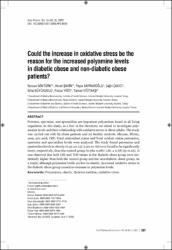| dc.contributor.author | Göktürk, Nurcan | |
| dc.contributor.author | Şahin, Hicret | |
| dc.contributor.author | Bayramoğlu, Feyza | |
| dc.contributor.author | Çakıcı, Çağrı | |
| dc.contributor.author | Büyükuslu, Nihal | |
| dc.contributor.author | Yiğit, Pakize | |
| dc.contributor.author | Yiğitbaşı, Türkan | |
| dc.date.accessioned | 2022-12-21T13:26:20Z | |
| dc.date.available | 2022-12-21T13:26:20Z | |
| dc.date.issued | 2022 | en_US |
| dc.identifier.citation | Göktürk, N., Şahin, H., Bayramoğlu, F., Çakıcı, Ç., Büyükuslu, N., Yiğit, P. ... Yiğitbaşı, T. (2022). Could the increase in oxidative stress be the reason for the increased polyamine levels in diabetic obese and non-diabetic obese patients? Acta Pharmaceutica Sciencia, 60(3), 301-312. https://doi.org/10.23893/1307-2080.APS.6020 | en_US |
| dc.identifier.issn | 1307-2080 | |
| dc.identifier.uri | https://doi.org/10.23893/1307-2080.APS.6020 | |
| dc.identifier.uri | https://hdl.handle.net/20.500.12511/10160 | |
| dc.description.abstract | Putresin, spermine, and spermidine are important polyamines found in all living organisms. In this study, as a first in the literature, we aimed to investigate polyamines levels and their relationship with oxidative stress in obese adults. The study was carried out with 85 obese patients and 29 healthy controls. Glucose, HbA1c, urea, uric acid, CRP, Total antioxidant status and Total oxidant status putrescine, spermine and spermidine levels were analysed. The study found putrescine and spermidine levels in obesity (0.25 ±0.13) (2.29 ±0.79) were found to be significantly lower, respectively, than the control group (0.38± 0.08) (1.80 ± 0.68) (p<0.05). It was observed that both OSI and TOS values in the diabetic obese group were statistically higher than both the control group and the non-diabetic obese group. As a result; although polyamine levels are low in obesity, increased oxidative stress in the diabetic obese group caused an increase in polyamine levels. | en_US |
| dc.language.iso | eng | en_US |
| dc.publisher | İstanbul Medipol University | en_US |
| dc.rights | info:eu-repo/semantics/openAccess | en_US |
| dc.subject | Polyamines | en_US |
| dc.subject | Obesity | en_US |
| dc.subject | Diabetes Mellitus | en_US |
| dc.subject | Oxidative Stress | en_US |
| dc.title | Could the increase in oxidative stress be the reason for the increased polyamine levels in diabetic obese and non-diabetic obese patients? | en_US |
| dc.type | article | en_US |
| dc.relation.ispartof | Acta Pharmaceutica Sciencia | en_US |
| dc.department | İstanbul Medipol Üniversitesi, Sağlık Bilimleri Enstitüsü, Tıbbi Biyokimya Ana Bilim Dalı | en_US |
| dc.department | İstanbul Medipol Üniversitesi, Tıp Fakültesi, Temel Tıp Bilimleri Bölümü, Tıbbi Biyokimya Ana Bilim Dalı | en_US |
| dc.department | İstanbul Medipol Üniversitesi, Sağlık Bilimleri Fakültesi, Beslenme ve Diyetetik Bölümü | en_US |
| dc.authorid | 0000-0002-5213-6933 | en_US |
| dc.authorid | 0000-0002-1757-9843 | en_US |
| dc.authorid | 0000-0002-0757-9743 | en_US |
| dc.authorid | 0000-0002-8662-5284 | en_US |
| dc.authorid | 0000-0003-1420-0989 | en_US |
| dc.authorid | 0000-0002-5919-1986 | en_US |
| dc.authorid | 0000-0002-0675-1839 | en_US |
| dc.identifier.volume | 60 | en_US |
| dc.identifier.issue | 3 | en_US |
| dc.identifier.startpage | 301 | en_US |
| dc.identifier.endpage | 312 | en_US |
| dc.relation.publicationcategory | Makale - Uluslararası Hakemli Dergi - Kurum Öğretim Elemanı | en_US |
| dc.identifier.doi | 10.23893/1307-2080.APS.6020 | en_US |
| dc.institutionauthor | Göktürk, Nurcan | |
| dc.institutionauthor | Şahin, Hicret | |
| dc.institutionauthor | Bayramoğlu, Feyza | |
| dc.institutionauthor | Çakıcı, Çağrı | |
| dc.institutionauthor | Büyükuslu, Nihal | |
| dc.institutionauthor | Yiğit, Pakize | |
| dc.institutionauthor | Yiğitbaşı, Türkan | |
| dc.identifier.scopus | 2-s2.0-85137365650 | en_US |
| dc.identifier.scopusquality | Q3 | en_US |


















